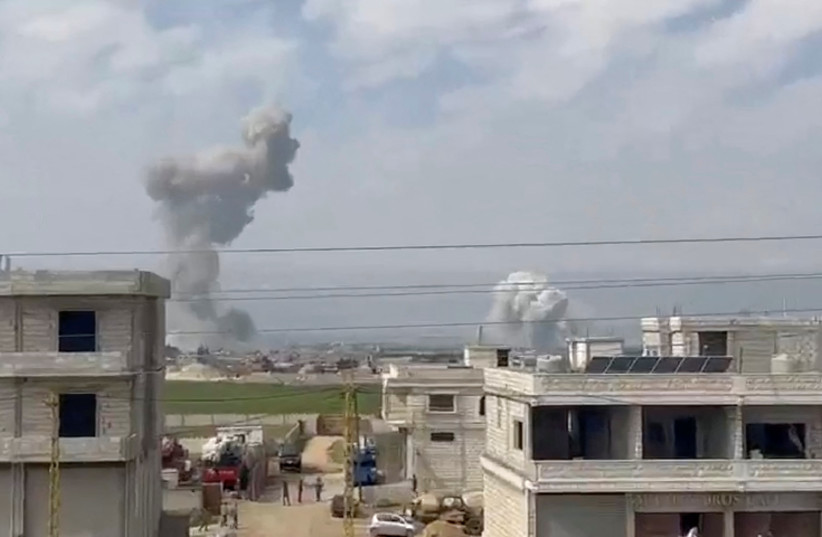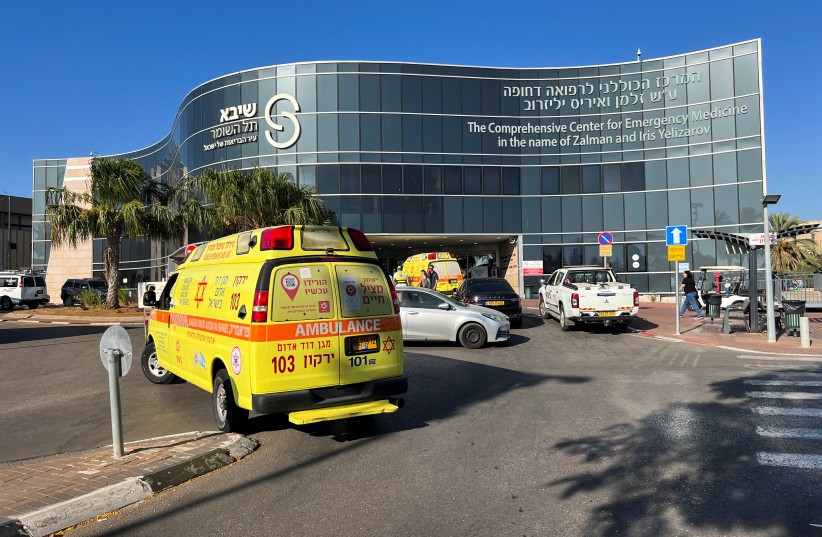IDF, Hamas exchange fire on Lebanon border; IDF to open new PTSD center
Unable to keep up serious rocket fire from Gaza, Hamas forces in Lebanon fired between 10-40 rockets at Israel in multiple rounds on Wednesday.
Hamas claimed that it fired 40 Grad rockets, but the IDF said only 10 made it into Israeli airspace with none causing injuries, though one had a direct hit on an evacuated house in Kiryat Shmona.
26 rocket sirens had sounded by late afternoon on Wednesday.
Responding, the IDF struck targets in four different parts of southern Lebanon.
It also said that it targeted the sources of the launch.
IAF jets also attacked a Hezbollah munition warehouse and military buildings in the Ramyeh region of southern Lebanon and in the middle of the night, the IDF attacked a Hezbollah weapon production site in the Khirbet Selm area.

Earlier on Wednesday, Hamas said in a statement on its Telegram channel that it had bombed the headquarters of the 769th Eastern Brigade and the airport barracks in Beit Hillel, which the IDF denied.
In recent days, the IDF and Hezbollah exchanges of fire have intensified and reached deeper into each side’s territory, but this was the first Hamas rocket attack on Israel from Lebanon in several weeks.
The IDF has killed dozens of Hamas terrorists in Lebanon and well over 200 Hezbollah terrorists.
IDF to establish new PTSD center
Separately, the IDF announced on Wednesday that it is establishing a new center for emotional distress, including post-traumatic stress disorder (PTSD) near Tel Hashomer Medical Center.
This new facility will strengthen the IDF’s already increased commitments to assisting soldiers in coping with emotional distress generally, and PTSD in particular, in the shadow of the longest Israeli war since 1948.
Following October 7, the IDF Medical Corps brought on 800 additional therapists to cope with the massive trauma that occurred to an unprecedented number of soldiers at the same time.
This move was also made to anticipate the additional traumas that soldiers would go through on the Gaza, Hezbollah, and West Bank fronts as the war would and has continued.
A much larger number of therapists made it possible to have an assigned therapist for each brigade, including therapists who entered Gaza with their brigades so they could be on the front lines and assist soldiers in real time.
To date, the IDF has said that 85% of those soldiers who have sought basic level assistance with trauma from the war have returned to serve in their units within a short amount of time.
Among those who sought more significant emotional assistance, around 50-60% eventually returned to serve in the IDF.
Being that significant numbers of soldiers did not seek any assistance, the number of soldiers who have PTSD to date (some only realize they have PTSD at a later date) is much smaller than the 10-50% of all soldiers which the IDF originally expected due to the extreme circumstances of Hamas’s October 7 massacre.
According to the IDF, its multiple levels for addressing soldiers’ needs at different levels has been successful.
Whereas the IDF Medical Corps received around 30,000 phone calls for assistance, a much smaller number of only a couple thousand soldiers needed much higher levels of assistance.

How is “success” measured in PTSD treatment?
Despite these positive-sounding statistics, there are always questions about how the IDF and other militaries measure “success” with PTSD.
Simply returning to serve in a war does not necessarily mean a soldier does not have PTSD and, in some cases, may even worsen the original PTSD symptoms.
In the face of this dilemma, IDF officials have said that the first and best way for most people to try to cope with trauma is to, after acknowledging the trauma, try to re-enter their normal lives and routines.
Whether this is true or not in the case of October 7 and the ongoing war may not be known for months or years, and may differ wildly based on specific individuals.
If the IDF was successful, senior officials would attribute part of that success to having gone through the traumatic coronavirus era.
During and following the coronavirus crisis, the IDF decided it would need far more resources and personnel to cope with emotional distress, especially for new recruits to the military who did not get to live routine lives as much in their later high school years.
Two years of work to try to shift in this direction were still moving slower, but gave the IDF a running start, such that when October 7 hit, there was no need to convince key decision-makers of the necessity for a major influx of therapists.
Controversially, the IDF has opposed working with larger groups of therapists who do not join the IDF, saying that the unique IDF experience and the different goals and manners of operation of civilian therapists do not match up for the military.
Israel, US and allies airdrop aid to Gaza
Meanwhile, as part of a joint-coordination effort, Israel, Jordan, Egypt, France, the United Arab Emirates, and the United States airdropped various supplies to Gazan residents, the IDF announced Wednesday.
The coordinated effort by these states saw supplies such as food and medical equipment airdropped to residents of southern Gaza and the Jordanian field hospital on Tuesday.
160 packages of food and medical equipment were transferred to Gazan residents in the southern Gaza Strip and the Jordanian field hospital in Khan Yunis. The effort was planned and coordinated by the International Brigade of the Strategic Planning and Cooperation Directorate (J5), the Coordination and Liaison Administration to Gaza (CLA), the IDF COGAT Unit, the 98th Division, and the IAF.
The food packages were airdropped over the span of the last two days to around 17 locations along the southern coastline of the Gaza Strip using French, American, Egyptian, Emirati, and Jordanian airplanes.
Further, IDF forces in the South, along with the air force, attacked eight targets in Gaza relating to the area from which rockets were launched towards Ashkelon on Tuesday, the military said on Wednesday.
Troops also targeted terror shafts and infrastructures from which terrorists exited to carry out terror activities in the Gaza Strip.
In western Khan Yunis, the 7th Brigade raided buildings where troops found weapons and military equipment.
In parallel, the troops killed five terrorists by firing a precise missile at a vehicle in which they were traveling. In addition, IAF jets attacked two military compounds, killing terrorists who were located in them, the military said.
Further north in Gaza, in In Zeitoun, the IDF 162nd Division identified a terrorist squad, which was subsequently eliminated by a combat helicopter.
IDF forces also attacked buildings used by Hamas in the al-Amal neighborhood and raided infrastructure in the Absan neighborhood, killing dozens of terrorists and finding weapons.
In a specific incident in the North, an IDF soldier sustained moderate injuries on Wednesday morning as a result of a military vehicle overturning in the Hermon area, the military said.
Two other soldiers were lightly injured in the incident as well.
The soldiers were rushed to hospital for further medical treatment.
Reuters contributed to this article.





Comments are closed.